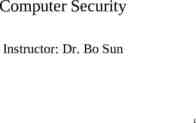FY 2018 President’s Budget U.S. Department of Education Tuesday, May
9 Slides413.00 KB

FY 2018 President’s Budget U.S. Department of Education Tuesday, May 23, 2017

2 “This budget makes an historic investment in America’s students. President Trump is committed to ensuring the Department focuses on returning decision-making power back to the States, where it belongs, and on giving parents more control over their child’s education. “By refocusing the Department’s funding priorities on supporting students, we can usher in a new era of creativity and ingenuity and lay a new foundation for American greatness.” — Betsy DeVos, U.S. Secretary of Education

3 FY 2018 Budget Themes Helps ensure every child has the opportunity to attend a high quality school selected by his or her parents Maintains strong support for the Nation’s most vulnerable students Simplifies funding for postsecondary education Continues to build evidence around educational innovation Acknowledges the appropriate Federal role in education by eliminating or reducing more than

4 The FY 2018 President’s budget provides: 59 billion in discretionary funding, a 9 billion or 13 percent decrease below the 2017 annualized CR level The budget also includes 134.2 billion in new postsecondary grants, loans, and work-study assistance The 2018 budget offers 1.4 billion toward new public and private school choice opportunities, enabling more students an equal opportunity at a great education

5 Increasing School Choice 1 billion increase for Title I for new Furthering Options for Children to Unlock Success (FOCUS) grants that would provide supplemental awards to school districts that agree to adopt weighted student-centered funding formulas combined with open enrollment systems 250 million increase for the Education Innovation and Research (EIR) program for competitive awards for applicants to provide scholarships for students from lowincome families to attend the private school of their choice 167 million increase for the Charter Schools program to strengthen State efforts to start new charter schools or expand and replicate existing high-performing charter schools while providing up to 100 million to meet the growing demand for charter school facilities

6 Supporting the Nation’s Most Vulnerable Students 14.9 billion in level funding for the core Title I Grants to LEAs program to support State and local efforts to ensure that more than 25 million students in high-poverty schools have access to rigorous coursework and teaching 12.7 billion to maintain the Federal investment in the Individuals with Disabilities Education Act formula grant programs, which help support services to the 6.8 million children with disabilities 736 million for the English Language Acquisition program to implement effective language instruction educational programs 492 million for Historically Black Colleges and Universities, Minority-Serving, and Hispanic-Serving Institutions through the Higher Education Act Titles III

7 Simplifying Funding for Postsecondary Education Streamlines subsidized student loans and replaces five different income driven repayment plans with a single plan aimed at prioritizing expedited loan repayment for undergraduate borrowers. Safeguards and strengthens the Pell Grant program by level funding the discretionary appropriation and reinstating the availability of year-round Pell, which will increase aid available by 16.3 billion over 10 years Eliminates Supplemental Educational Opportunity Grant (SEOG) program, which is largely duplicative of Pell Reduces Federal Work-Study while reforming the poorlytargeted allocation to ensure funds go to undergraduate students who would benefit most

8 Building Evidence around Educational Innovation 617 million for the Institute of Education Sciences (IES) for continued support of research, evaluation, and statistics that help educators, policymakers, and other stakeholders improve outcomes for all students 370 million for Education Innovation and Research to expand support for evidence based initiatives to develop, validate, and scale up effective education interventions that help States and LEAs meet ESEA requirements 42 million for Supporting Effective Educator Development (SEED) to provide evidence-based professional development activities and prepare teachers and principals from nontraditional preparation and certification routes to serve in high-need LEAs

9 Eliminating or Reducing Redundant and Ineffective Programs Eliminates funding for Supporting Effective Instruction State grants (Elementary and Secondary Education Act (ESEA) Title II-A), a reduction of 2.3 billion. The program is proposed for elimination because evidence shows that the program is poorly structured to support activities that have a measurable impact on improving student outcomes and it duplicates other ESEA program funds that may be used for professional development Eliminates funding for the 21st Century Community Learning Centers program, saving 1.2 billion. The program lacks strong evidence of meeting its objectives, such as improving student achievement Eliminates Striving Readers/Comprehensive Literacy Development Grants, which will save 190 million. This program has limited impact and duplicates activities that may be supported with other Federal, State, local, and






